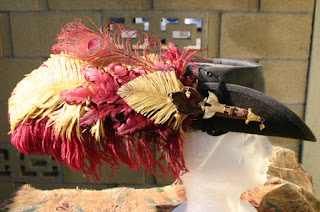The Genus Piraticus comes
in several species and sub-species, most notably Piraticus Historius (historic-reenactor pirates) , Piraticus Festivus (Pirate Festival
pirates), and today’s species of
study, Piraticus Faireus – that species
of pirates common to Renaissance Faires.
At first glance, it would seem that Renaissance pirates would be
easy to spot. They would reenact with a slant toward the Buccaneering era of
pirates, and favor slashed doublets, muffin
caps and bollocks daggers- a great look for a pirate.
However, in practice this is not the case at all. When
observing pirates at most Ren Faires, even the casual observer will notice at
once that these pirates are not rooted in any particular time. They are most
especially not related to the swashbuckling pirates of the English Renaissance.
Instead, the largest group of these pirates come to us from the realm of pure
fantasy.
These pirates are most noted for their extensive use of the
color black. Although black has not been associated with any working class
occupation (and even the most dashing of historical pirates were definitely
blue-collar) the pirates who attend renaissance fests are often covered in
black from head to toe. This is especially notably because the color is so impractical.
Summer events, especially in Midwestern America (my home grounds) often sport
temperatures in the mid 90’s (Fahrenheit – perhaps 33 degrees Celsius).
Males of this species are a fairly homogeneous lot. The
look is black pants – very tight black pants, often even tights – and sometimes
even skin-tight black leather pants. The shirt – usually baggy in the “poet”
style – is usually black as well, although other historically inaccurate colors
such as red, burgundy and dark brown are also frequently seen. A black leather vest is also often in
evidence.
Footgear for these pirates is often very distinctive.
Although historic pirates wore buckled shoes almost exclusively, or went
barefoot while on ship, our Renaissance pirates show nary a shoe. The foot
covering of choice is a high boot. “Bucket boots” of the type favored by Jack
Sparrow in the POTC movies are very common. Loosely based on a type of riding boot favored
by the nobility of approximately 100 years before the Golden Age of Piracy,
these boots have a wide top that can be worn folded over for walking, or pulled
up over the thigh for riding through rough county.
The Ren Faire version has lost this ability. The “buckets”
or turned-down upper part of the boot is far too narrow to be pulled up as any
sort of protection. Instead, they remain as a fashion statement.
Another popular style of footwear can only be described as a
“Ren Faire boot”. This design was invented by Ren Fair craftsmen, who used
modern materials and a smattering of historical research to create a boot that “could
have existed” during the renaissance, but didn’t.
Comfortable and durable, these boots often cost many hundreds
of dollars. They usually lace up the front or sides, often with an incorporated
button design. For a more piratical look, buckles are often substituted for the
buttons. These boots look like nothing out of history, and their knee-high
tight leather construction makes them hot, but they remain popular.
Piratical hats are also of a strange variety. Although in many venues the tricorne, a historically
accurate hat, marks one as a pirate, the Ren Fair crowd is not to be satisfied
with a common tricorne. Instead, these hats are extravagantly decorated with
feathers and jeweled clips. Faire
vendors stock plenty of hat pins featuring a skull-and-crossbones, crossed
swords, or an octopus (a symbol favored by Faire pirates since Davey Jones in
POTC 2 – Dead Man’s Chest).
In order to support yet more feathers, some pirates favor
hats of the Cavalier style. These fanciful constructions can carry trailing
feathers that rival a peacock’s tale – and must be equally difficult to carry
around.
The female of the species Piraticus Faireus come in two distinct species – the Bawdy Wench
and the Hard-as-Nails Hellion. Either or both may display a huge amount of bosom.
The Wench, however, usually wears
skirts, often hiked to above the knees with leather skirt-lifters. She is usually not as well-armed as the
Hellion. Many Wenches are young and frolicsome, and are often wearing little beside
a corset (usually from the Victorian era) a skirt, boots and a pirate hat. Often
the Wench’s hat becomes an extravagant affair. I have seen women at Ren Fairs
wearing hats with entire Spanish Galleons on them, in addition to yards of lace
and pounds of jewels.
Often the Wench has kept company with a belly-dancer, or a
belly-dancer has decided to become a wench. Yards of silk scarves are in evidence on these
costumes, as well as Middle-Eastern tribal jewelry, the occasional turban, and
a bare midriff. Since belly-dancers frequently carry scimitars, it may be difficult
to tell where one occupation takes up and another leaves off… But by my
estimation, if the woman is wearing flintlock pistols, she probably identifies
as a pirate.
In contrast, the Hellion is often older, and is often firmly
attached to a male of the species. Her display of bosom is often deeper but
narrower, and her clothing may perfectly echo the male. The younger examples of
the Hellion often wear spike-heeled boots of extravagant proportions. Older women favor tall, flat heeled boots. Often these women carry lots of steel… Sword,
several daggers, stilettos (besides the ones on their shoes) and often a whip. This is the perfect costume for a
woman with a take-no-nonsense attitude.
Faire pirates carry a lot of weapons in general. They
usually resemble a boarding party, rather than a night on the town. Often the weapons of choice are broadswords
or fencer’s rapiers. Many pistols are in evidence. Some pirates are carrying so
much weaponry that it’s hard to tell how they move. And if weapons don’t take over, other accouterments
may. The pirate may carry compasses,
tankards, keys, extra scarves, manacles, and just about every other cool-looking
vaguely piratical object that the Faire may wish to sell.
So what do I think of the Ren Faire pirate? As a species
they are fun. Certainly, in my opinion, any pirate costume is better than no costume
at all. And the amount of time and money invested in these costumes shows a certain
dedication to the persona. But they are a species and a culture unto themselves – not much
related to history at all.
That’s a shame, because the history of pirates – and their
radical stroke for equality and generosity is worth knowing about . I guess I’ll
take my pirates where I can get them however. As long as they’re a jolly crew.











As a long time Faire-goer and licensed Wench, this is 100% accurate.
ReplyDeleteAs a long-time member of the SCA, on the side of "the more authentic the better," this is 100,000% accurate.
Thank you for sharing :D
Who hurt you and why does it matter so much? Lol
ReplyDelete